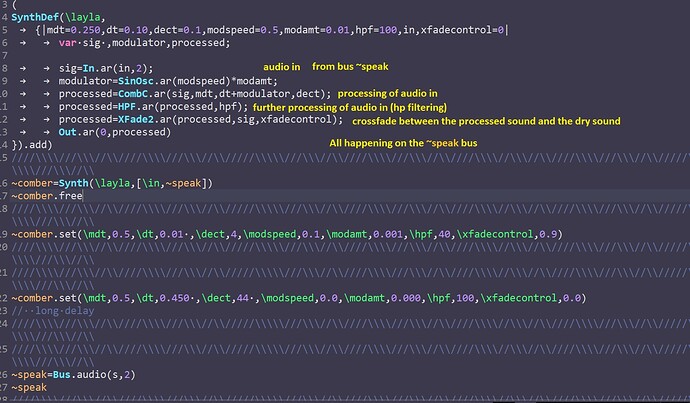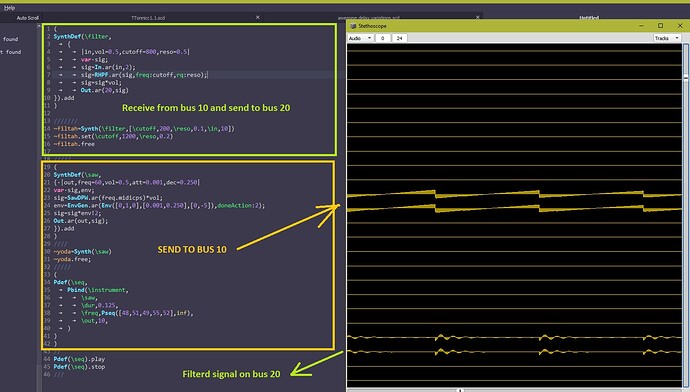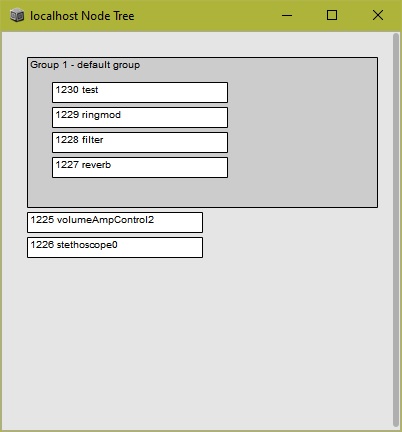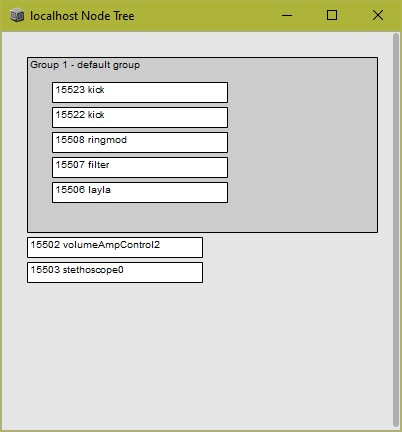O.k I think I’ve got it
These are two examples of serial effects routing
The first piece of code is simply using output numbers
Synthdef saw goes into filter then in delay ,delay goes to output
you can varry the crossfade
Order of execution
Execution of busses is not necessary ( in this example )
First execute synthdef layla and ~comber=synth
The execute filter synthdef and ~filtah=Synth
This will bring the filter on top of the group , so first filtering then delay
You can alter the filter frequency by executing ~filtah.set second line , or set xfade in the
first ~comber.set line to +1 to let the filtered signal through but unnafected by delay
Lastly execute saw +pbind
~filterbus=Bus.audio(s,2)///bus 4
~filterbus
~delaybus=Bus.audio(s,2)//bus 6
~delaybus
~testbus=Bus.audio(s,2)//bus 8
~testbus
(
SynthDef(\filter,//takes saw input and filters it the sends it to ~delaybus
{
|in,out,vol=0.5,cutoff=800,reso=0.5,xfade=(-1)|
var sig,processed;
sig=In.ar(in,2);
processed=RHPF.ar(sig,freq:cutoff,rq:reso);
processed=XFade2.ar(processed,sig,pan:xfade);
Out.ar(out,processed)
}).add
)
//...
(
SynthDef(\layla,///takes input from the filtered signal and sends it to bus 0
{|mdt=0.250,dt=0.10,dect=0.1,modspeed=0.5,modamt=0.01,hpf=100,in,xfadecontrol=0,out|
var sig ,modulator,processed;
sig=In.ar(in,2);
modulator=SinOsc.ar(modspeed)*modamt;
processed=CombC.ar(sig,mdt,dt+modulator,dect);
processed=HPF.ar(processed,hpf);
processed=XFade2.ar(processed,sig,xfadecontrol);
Out.ar(out,processed)
}).add)
///......
~comber=Synth(\layla,[\in,12,\out,0,\dt,0.222,\dect,2,])///delay
~comber.set(\mdt,0.5,\dt,0.25 ,\dect,4,\modspeed,0.001,\modamt,0.001,\hpf,40,\xfadecontrol,-1)//crossfade between -1 totally wet delay or 1 no delay
~comber.set(\in,12,\out,0)
~comber.set(\in,~delaybus,\out,0)
~comber.set(\in,~testbus,\out,0)
~comber.set(\in,18,\out,0)
~comber.set(\in,20,\out,0)
~comber.free
~comber.set(\mdt,0.5,\dt,0.25 ,\dect,4,\modspeed,0.001,\modamt,0.001,\hpf,40,\xfadecontrol,-1)//crossfade between -1 totally wet delay or 1 no delay
///////
~filtah=Synth(\filter,[\cutoff,2000,\reso,0.1,\in,10,\out,12,\xfade,-1])//crossfade between a filter saw =(-1) or a dry saw =1
~filtah.set(\cutoff,3500,\reso,0.3,\xfade,-1,\out,0,\xfade,-1,\in,10,\out,12)
~filtah.set(\cutoff,15000,\reso,0.3,\xfade,-1,\out,~testbus,\xfade,-1)
~filtah.set(\cutoff,1200,\reso,0.3,\xfade,-1,\out,14,\xfade,-1)
~filtah.set(\cutoff,1200,\reso,0.3,\xfade,-1,\out,16,\xfade,-1)
~filtah.set(\cutoff,1200,\reso,0.3,\xfade,-1,\out,18,\xfade,-1)
~filtah.set(\cutoff,1200,\reso,0.3,\xfade,-1,\out,20,\xfade,-1)
~filtah.free
/////Unfiltered saw goes to filterbus
(///execute last !
Pdef(\seq,
Pbind(\instrument,
\saw,
\dur,Pseq([1/4,1/4,1/2],inf),
\freq,Pseq([48,50,53,57],inf),
\dec,Pseq([0.120,0.050,0.200,0.050,0.725,0.125,0.01,0.02,0.02,0.02,0.02,0.5],inf),
\out,10,
)
)
)
//
t=TempoClock(96/60).permanent_(true)
Pdef(\seq).play(t)
Pdef(\seq).stop
//////////////
/////
(
SynthDef(\saw,
{ |out,freq=60,vol=0.5,att=0.001,dec=0.0250|
var sig,env;
sig=SawDPW.ar(freq.midicps)*vol;
env=EnvGen.ar(Env([0,1,0],[att,dec],[0,-5]),doneAction:2);
sig=sig*env!2;
Out.ar(out,sig);
}).add
)
////
The second piece of code is identical but using busses , so executing busses first , rest is thesame
~filterbus=Bus.audio(s,2)///bus 4
~filterbus
~delaybus=Bus.audio(s,2)//bus 6
~delaybus
~testbus=Bus.audio(s,2)//bus 8
~testbus
(
SynthDef(\filter,//takes saw input and filters it the sends it to ~delaybus
{
|in,out,vol=0.5,cutoff=800,reso=0.5,xfade=(-1)|
var sig,processed;
sig=In.ar(in,2);
processed=RHPF.ar(sig,freq:cutoff,rq:reso);
processed=XFade2.ar(processed,sig,pan:xfade);
Out.ar(out,processed)
}).add
)
//...
(
SynthDef(\layla,///takes input from the filtered signal and sends it to bus 0
{|mdt=0.250,dt=0.10,dect=0.1,modspeed=0.5,modamt=0.01,hpf=100,in,xfadecontrol=0,out|
var sig ,modulator,processed;
sig=In.ar(in,2);
modulator=SinOsc.ar(modspeed)*modamt;
processed=CombC.ar(sig,mdt,dt+modulator,dect);
processed=HPF.ar(processed,hpf);
processed=XFade2.ar(processed,sig,xfadecontrol);
Out.ar(out,processed)
}).add)
///......
~comber=Synth(\layla,[\in,~delaybus,\out,0,\dt,0.222,\dect,2,])///delay
~comber.set(\in,12,\out,0)
~comber.set(\in,~delaybus,\out,0)
~comber.set(\in,~testbus,\out,0)
~comber.set(\in,18,\out,0)
~comber.set(\in,20,\out,0)
~comber.free
~comber.set(\mdt,0.5,\dt,0.325 ,\dect,4,\modspeed,0.001,\modamt,0.001,\hpf,40,\xfadecontrol,-1)//crossfade between -1 totally wet delay or 1 no delay
///////
~filtah=Synth(\filter,[\cutoff,2000,\reso,0.1,\in,~filterbus,\out,~delaybus,\xfade,-1])//crossfade between a filter saw =(-1) or a dry saw =1
~filtah.set(\cutoff,3500,\reso,0.3,\xfade,-1,\out,0,\xfade,-1,\in,~filterbus,\out,~delaybus)//change frequency
~filtah.set(\cutoff,15000,\reso,0.3,\xfade,-1,\out,~testbus,\xfade,-1)
~filtah.set(\cutoff,1200,\reso,0.3,\xfade,-1,\out,14,\xfade,-1)
~filtah.set(\cutoff,1200,\reso,0.3,\xfade,-1,\out,16,\xfade,-1)
~filtah.set(\cutoff,1200,\reso,0.3,\xfade,-1,\out,18,\xfade,-1)
~filtah.set(\cutoff,1200,\reso,0.3,\xfade,-1,\out,20,\xfade,-1)
~filtah.free
/////Unfiltered saw goes to filterbus
(///execute last !
Pdef(\seq,
Pbind(\instrument,
\saw,
\dur,Pseq([1/4,1/4,1/2],inf),
\freq,Pseq([48,50,53,57],inf),
\dec,Pseq([0.120,0.050,0.200,0.050,0.725,0.125,0.01,0.02,0.02,0.02,0.02,0.5],inf),
\out,~filterbus,
)
)
)
//
t=TempoClock(96/60).permanent_(true)
Pdef(\seq).play(t)
Pdef(\seq).stop
//////////////
/////
(
SynthDef(\saw,
{ |out,freq=60,vol=0.5,att=0.001,dec=0.0250|
var sig,env;
sig=SawDPW.ar(freq.midicps)*vol;
env=EnvGen.ar(Env([0,1,0],[att,dec],[0,-5]),doneAction:2);
sig=sig*env!2;
Out.ar(out,sig);
}).add
)
////
 ,it’s two days since I started exploring busses
,it’s two days since I started exploring busses


